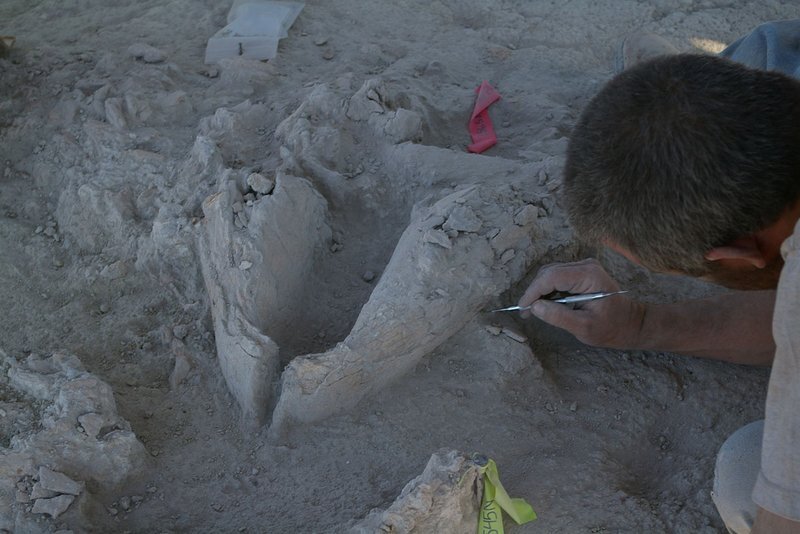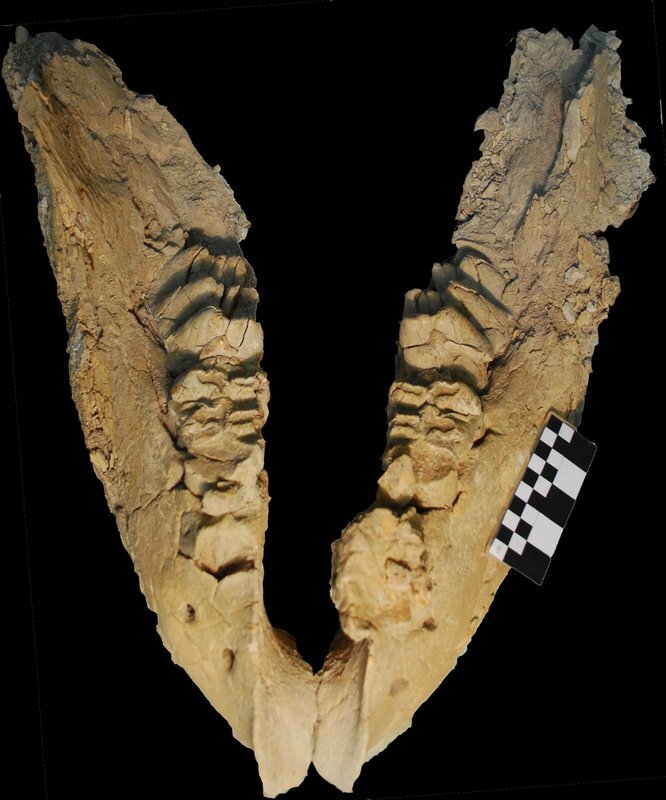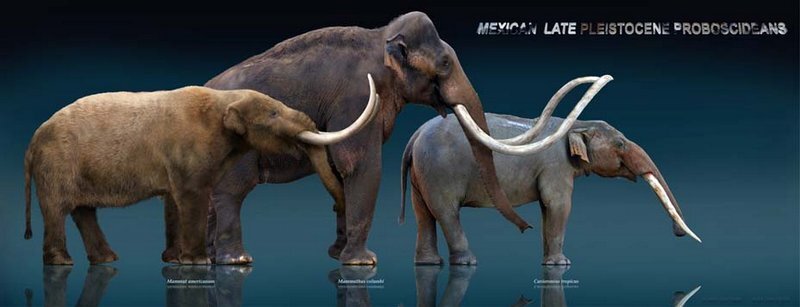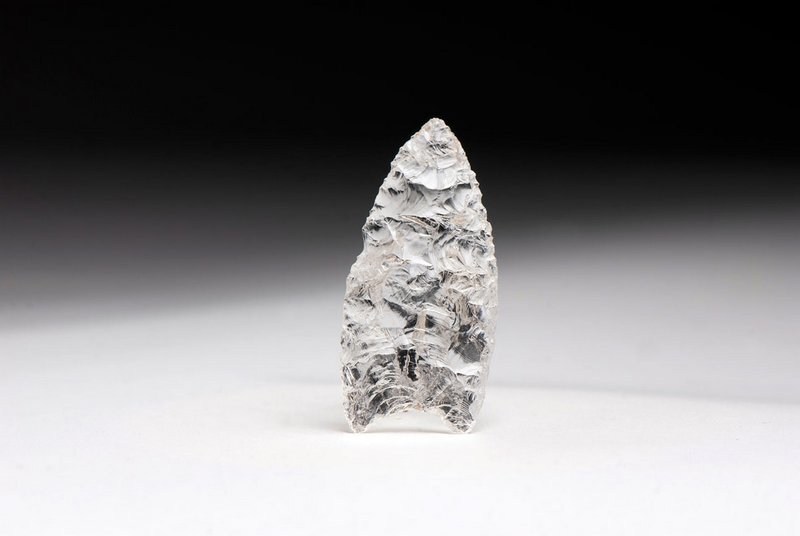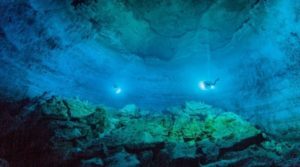
Tulum, Quintana Roo, in the Yucatán Peninsula of Mexico — It was in May of 2007 when the divers approached it—a cenote deep inside the jungle. Cenotes, or water-filled sinkholes, are not uncommon in these parts. In fact, in the Yucatán, they exist by the thousands. Divers and archaeologists alike love them for the secrets they hide — secrets that could reveal much about a past human presence in a subtropical world that seemed to serve as an unlikely setting for one of the greatest of ancient civilizations, the Maya. Alberto Nava, who took the lead on this dive, is something of a veteran when it comes to such ventures. He is a professional diver with the Bay Area Underwater Explorers, a California-based nonprofit organization dedicated to exploration and conservation of the world’s underwater regions. With his two other diving companions, Alex Alvarez and Franco Attolini, he plunged into the cenote, an entry into an elaborate underwater cave system known as the Sac Actun. It was not unlike most any other dive — until they encountered an unexpected drop.
“We traveled through a flooded tunnel for about 1 mile before we reached the edge of this pit,” recounts Nava. “The floor disappeared under us, and we could not see across to the other side. We pointed our lights down and to the sides. All we could see was darkness. We felt as if our powerful underwater lights were being absorbed by this void, so we called it Black Hole, which in Spanish is Hoyo Negro.”
Nava and his colleagues could see that there was much more to this than they could absorb on a first dive. So they waited for another day.
“A couple of months later, we ventured deeper into this darkness and reached the floor of the pit at about 170 feet. It was a bell-shaped structure 200 feet in diameter. The center was littered with large boulders stacked on top of each other. As our eyes got accustomed to the environment, we started to notice large animal bones. The first one we found was a 3- foot-long femur resting against one of the boulders. My teammates started signaling in all directions as they pointed to animal remains that were resting at the bottom and on the walls of the pit. At that time, we were not sure what kind of bones we were looking at, but we knew they were old and big. All of the sudden, Alex pointed to a human skull resting on the top of a small ledge. It was a small cranium laying upside down with a perfect set of teeth and dark eye sockets looking back at us. The skull was resting on its humerus, and we could see the rest of the upper torso spread to the left and down on the ledge.”
As they usually did when encountering new finds, they began documenting the site. But they could see that this was a discovery that required more specialized attention.
“In 2009, we reported the site to archaeologist Pilar Luna from Mexico’s National Institute of Anthropology and History (INAH), and together we created the Hoyo Negro Consortium (www.hoyonegro.org ), a group of cave divers and researchers working to unravel the mysteries of Hoyo Negro.”
With this, the real scientific journey began at full throttle.
__________________________________
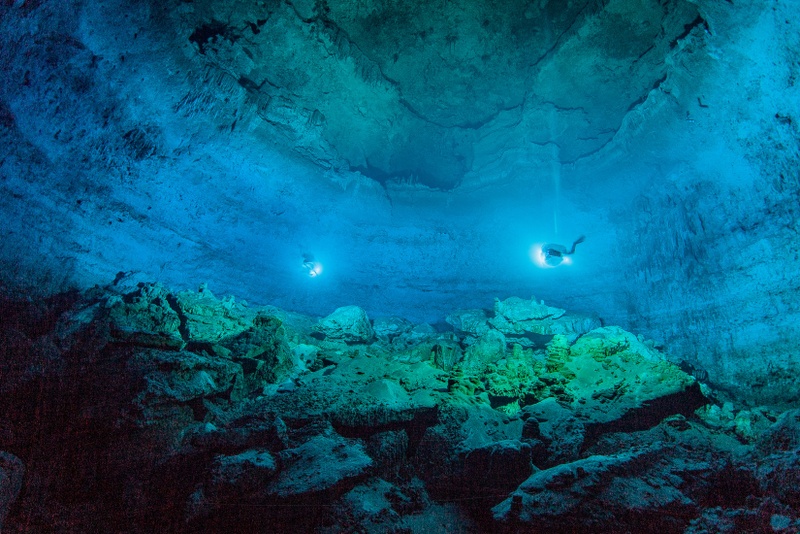 A broad view of Hoyo Negro, shot from the floor near the south edge, showing the immensity of the chamber and the complexity of the boulder-strewn bottom. One access tunnel can be seen near the ceiling at top left. This photo was taken by the “painting with light” method on a 30 second exposure. Text and photo credit: Roberto Chavez Arce
A broad view of Hoyo Negro, shot from the floor near the south edge, showing the immensity of the chamber and the complexity of the boulder-strewn bottom. One access tunnel can be seen near the ceiling at top left. This photo was taken by the “painting with light” method on a 30 second exposure. Text and photo credit: Roberto Chavez Arce
_________________________________________________
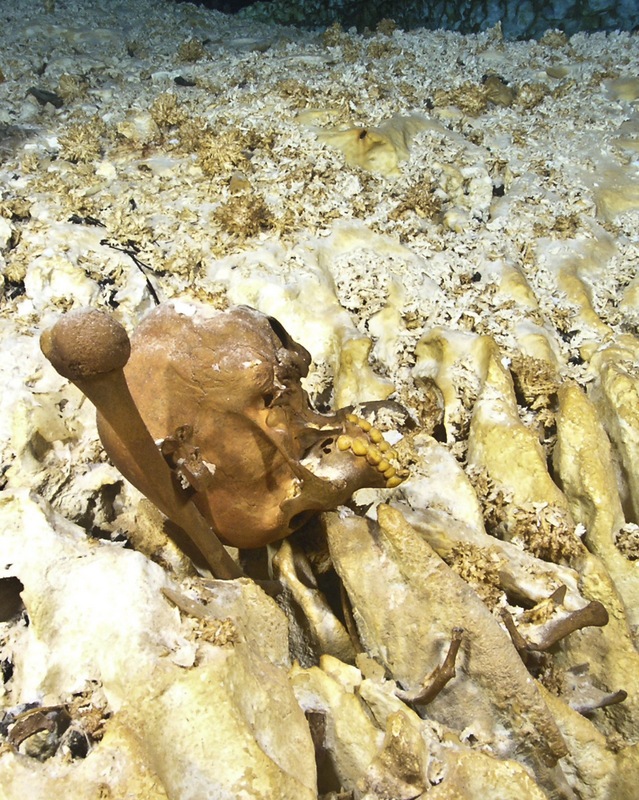 The skull as it was discovered in 2007, resting against the left humerus (upper arm bone).
The skull as it was discovered in 2007, resting against the left humerus (upper arm bone).
Photo and text credit: Daniel Riordan Araujo
___________________________________________________
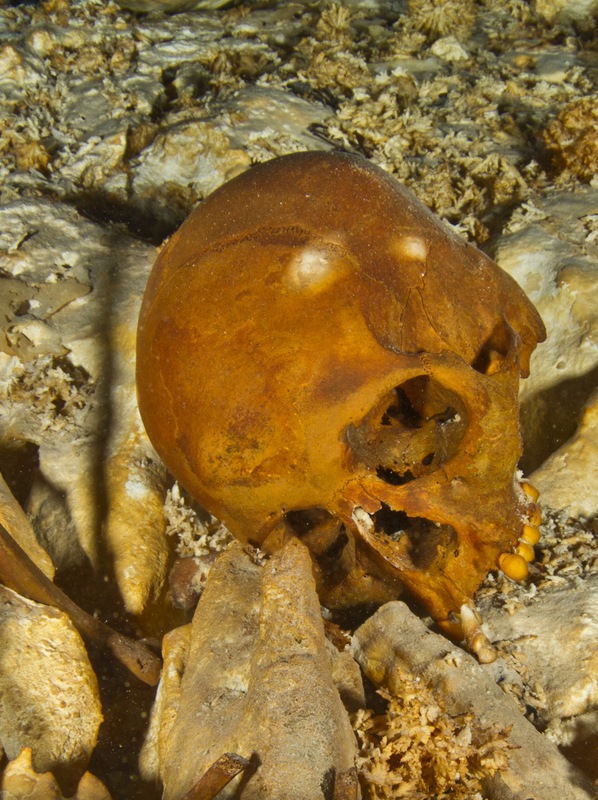 The skull as it appeared in December 2011, after rolling into a near-upright position.
The skull as it appeared in December 2011, after rolling into a near-upright position.
Photo credit: Roberto Chavez Arce
_____________________________________________
The Cave and The Water Nymph
Under the auspices of the new consortium, the task now fell to an international interdisciplinary team of scientist-specialists to undertake the meticulous job of additional recording, recovery, examination, and analysis of the various finds — finds that would eventually lead to some headline-making conclusions.
For the anthropologists and archaeologists of the group, the greatest excitement naturally focused on the human remains, what was turning out to be a nearly complete skeleton. But before anyone could understand the age and significance of the skeleton, they needed to understand the context. This required the efforts of specialists with knowledge of things like geology and cave formation, paleontology, dating techniques, and genetics.
Patricia Beddows of Northwestern University is one of those specialists. Her work has focused on cave systems formed by the dissolution of soluble carbonate rocks like limestone and dolomite, especially the flooded caves of the Yucatán Peninsula, including Hoyo Negro. She has logged countless hours diving into the cave systems. “Research in flooded caves is much like space exploration, with divers similar to astronauts reporting back to ‘mission control’ — a much larger scientific team at the surface,” said Beddows. “It all has to be done on SCUBA, which is our life support system.” Beddows’ studies have shown how the extensive Yucatán cave system has drained groundwater to the coast and how the water level in the caves has closely matched the sea level changes over time. “Using this knowledge, we understand how Hoyo Negro has changed over thousands of years,” she says. This has helped to date Hoyo Negro, once a drier cave chamber with lower water levels, to more than 12,000 years ago, when many of the bones or animals, including the human, had apparently fallen into or entered the cave. Her work with the re-crystalized rock sediments in the cave system also helped. The rocks and the bones in Hoyo Negro are coated with rock crystals, including a new form of crystal that Beddows calls “florets”. Using Uranium/Thorium dating analysis, scientists have been able to accurately and reliably date the bone. “An impressive aspect of this research is that we have dated the skeleton directly, but we also have supported these dates with additional dates on the florets,” Beddows said.
But narrowing down the dating has been very much a team effort, with a multi-pronged approach. To begin with, the cave-diving scientists knew that the human skeleton was found within the context of the skeletal remains of 26 large mammals, many of which were identified as the bones of long-extinct fauna, such as saber-toothed cats and gomphotheres (extinct relatives of mastodons). These are mammals that lived more than 11,000 years ago. The human skeleton was found near the bones of a gomphothere. Douglas Kennett, professor of environmental archaeology at Penn State, and Brendan J. Culleton, postdoctoral fellow in anthropology at Penn State, worked with colleagues to construct a geochronological framework for the skeleton by using a combination of methodologies that successfully constrained the age to the end of the Ice Age, the Late Pleistocene. Working with Yemane Asmerom and Victor Polyak from the University of New Mexico, they applied global sea level rise data to determine when the cave system filled with water. As the bones now lie about 130 feet below sea level, they estimated that sea level rise would have raised the groundwater level in the cave system and submerged the bones between 9,700 and 10,200 years ago. Thus, the latest animals and humans could have entered the cave system in a dry state was about 9,700 years ago.
In addition, enamel extracted from a tooth of the skeleton was radiocarbon dated to 12,900 years ago by Kennett’s lab.
“Unfortunately, we can’t rule out that the tooth enamel is contaminated with secondary carbonates from the cave system, but we removed potential contaminates using standard techniques and Tom Stafford, Stafford Research Laboratories, produced a comparable age,” said Kennett. “We consider this a maximum age and when combined with the uranium thorium dates from the adhering speleothems, we argue that the skeleton dates between 12,000 and 13,000 years ago. Well placed as a Paleoamerican.”
A Paleoamerican. This was something quite different than an ancient Mayan. The Maya, best known for the iconic monumental Mesoamerican cities like Chichen Itza, Tikal, and Copan, lived and dominated Central America from about 2000 B.C to about 1500 A.D. The Paleoamericans lived thousands of years earlier, inhabiting the American continents during the final glacial episodes of the late Pleistocene period, as far back as 15,000 years ago. The bones of this skeleton were dated to between 12,000 and 13,000 years ago. This represented one of the six oldest humans found in America. And it was certainly the most complete find for that time period.
But there was more to the skeleton than age. After examination, the team determined that the skeleton belonged to a slightly-built, 4-foot-10-inch girl of between 15 and 16 years of age. A teenager. She may have fallen into the pit while searching for water more than 12,000 years ago, the team surmised. A plausible scenario, as there was no evidence that she had been attacked, killed and dragged into the cave chamber by another preying animal. Scientific teams like to give nick-names to their biggest finds, especially if they are human skeletons. So the Hoyo Negro team called this one Naia, a greek reference to a water nymph. The name stuck and, along with names like “Lucy”, “Turkana Boy” and “Kennewick Man”, “Naia” was soon becoming something of a household word among scientists and the public, alike.
More important to the scientists, however, was that her features were consistent with those often attributed to Paleoamericans based on previous excavations and studies. “The earliest human skeletons found in the Americas differ markedly from those of modern Native Americans in the shapes of their skulls, faces and teeth,” said Dr. James C. Chatters of Applied Paleoscience, lead author of a recently published study related to the Hoyo Negro finds. The 9,000+-year-old Kennewick Man, found near Kennewick in Washington State in 1996, and also examined by Chatters, was a prime example.
Deciphering the ancestry of the first people to populate the Americas has been a challenge. On the basis of some genetic studies, modern Native Americans are thought to descend from Siberians who moved into eastern Beringia (the landmass that anciently connected Asia and North America) between 26,000 and 18,000 years ago. These people, considered the earliest Americans, are suggested to have then spread southward and populated the rest of the continent. But despite widespread support for this idea, the ancestry of the earliest Americans is still debated because, among other things, the facial features of the oldest American skeletons don’t look much like those of modern Native Americans. Thus, in terms of the Native American origins debate, the Hoyo Negro story is significant. And to this, the genetics contingent of the team had something to say about Naia………….
Haplogroups and Beringia
As is often the case, interdisciplinary scientific teams often turn to the best technical experts when it comes to finding answers to their questions. So it was that the Consortium approached Applied Paleoscience founder and Director James Chatters, a forensic anthropologist, archaeologist, and paleontologist. It was Chatters who played the lead role in the study of the famous Kennewick Man, and it is Chatters who is now leading the examination and analysis of Naia’s remains, resulting in a recently-published study that has catapulted Naia front-and-center on the stage of Native American origins research.
For the genetic examination component, Chatters recruited Brian Kemp of Washington State University to take the lead. Using the latest techniques, Kemp, a molecular anthropologist with expertise in the field of ancient human genetics, has sequenced DNA from ancient human remains found in both North and South America, including human coprolites — ancient excrement — from archaeological sites in Oregon and the American Southwest. His task was to tease out small amounts of Mitochodrial DNA (mtDNA), found in the energy-generating structures of cells, of one of Naia’s teeth. Isolating and sequencing mtDNA is common among studies of ancient human remains, as organisms contain many more copies of it than chromosomal DNA. And because it is inherited from the mother, one can determine maternal ancestry.
Extracting and analyzing Naia’s DNA was challenging, to say the least. “There is very little DNA preserved in a skeleton of such great antiquity,” said Kemp.
But because mtDNA is so much more plentiful than chromosomal DNA, and because scientists have now clocked years of experience sequencing mtDNA from ancient bones, it was a feasible undertaking. Using molecular biological techniques to amplify the DNA, Kemp was able to make hundreds of billions of copies of Naia’s original DNA material. “Once so many copies are made,” said Kemp, “it is pretty straightforward to study the DNA.”
The study results were enlightening. Kemp had determined that Naia shared a common ancestry with many of today’s Native Americans — a genetic signature that is derived from an Asian lineage but is only found in the Americas today. Called Haplogroup D1, it is found throughout North, Central and South America. It is thought that about 11% of Native Americans exhibit this haplogroup — especially in South America, where it shows up in about 29% of indigenous Chileans and Argentinians. Geneticists theorize that this lineage arose in Beringia after the ancient Beringian population separated from other Asian populations.
Kemp then asked two other expert colleagues to conduct similar tests on Naia’s tooth to verify his results. Deborah Bolnick, assistant professor of anthropology at the University of Texas at Austin, came up with essentially the same results. University of Illinois anthropology and Institute for Genomic Biology professor Ripan Malhi, focusing on regions of the mitogenome that mutate more slowly than other parts of the genome (and thus could be more reliable markers of genetic relatedness through time), also corroberated Kemp’s results.
Three separate labs had confirmed the same results. Naia, a Paleoamerican with physical characteristics distinctly different than today’s Native Americans, shared the same ancestry — an ancestry that pointed to ancient Beringia — and by extension to Asia.
The finding was not altogether startling. Previous studies have indicated similar results. But this is the first time that a nearly complete skeleton of this age has been genetically linked to today’s Native Americans, and protractively to Beringia and Asia. “Because she exhibits distinctive Paleoamerican skull and facial features,” says Bolnick, “the study shows for the first time that Paleoamericans with these distinctive features can have Beringia ancestry.”
Yet, what accounts for these different physical characteristics?
It could be evolution, suggests Bolnick and colleagues. “It seems likely that differences between Paleoamericans and Native Americans of today are due to evolutionary changes that occurred in Beringia and the Americas over the last 9,000 years,” she says. To support her suggestion, Bolnick points to evolutionary changes that have occurred over the last 10,000 years in other populations — a comparatively short time period on the evolutionary time scale, traditionally measured in millions of years. “There have also been studies of the skeletal morphology in later remains discovered in the Americas over the last 10,000 years. We certainly do see changes in the skull shape, in the facial features over that period of time.” She points additionally to Native American populations in South America who live at high altitudes, who evolved genetic and physical characteristics that have facilitated their survival in these regions.
____________________________________
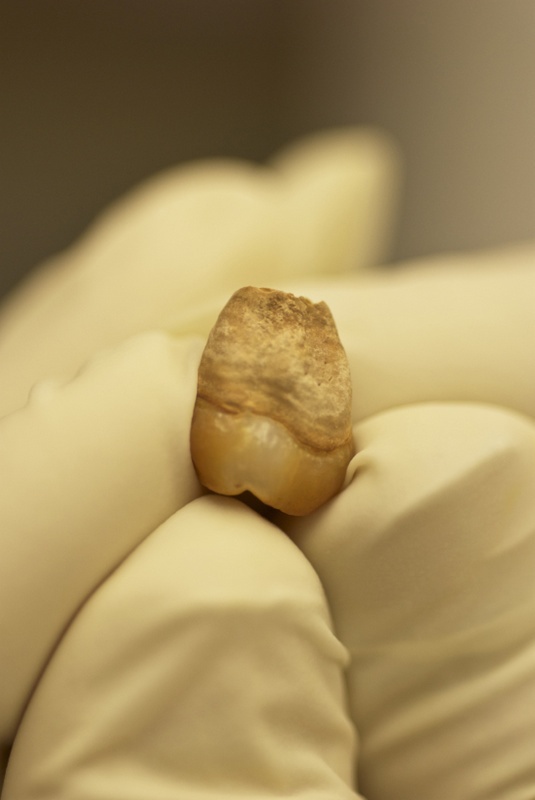 The upper right third molar of Naia, which was used for both radiocarbon dating and DNA extraction. The tooth is held by ancient genetics expert Brian Kemp of Washington State University, who led the genetic research on the skeleton. Photo credit: James Chatters
The upper right third molar of Naia, which was used for both radiocarbon dating and DNA extraction. The tooth is held by ancient genetics expert Brian Kemp of Washington State University, who led the genetic research on the skeleton. Photo credit: James Chatters
________________________________________________
The 10,000-Year Homeland
The Naia story and its evolutionary element have important implications in connection with other recent studies related to Native American origins. Some of them revolve around one emerging theory that has drawn the focus and attention of researchers from all over the world. Known as the “Beringia Standstill” theory, it was first suggested by two Latin American geneticists in 1997 and then refined or corroborated by a University of Tartu research team in Estonia in 2007. From a sampling of mitrochondrial DNA from more than 600 Native Americans, they found that mutations in the DNA pointed to the likelihood that a group of their direct ancestors from Siberia was isolated from their Siberian origins for at least several thousand years, during the time period from 25,000 (if not earlier) to 15,000 years ago (when ice-free corridors developed), before their descendants moved into the Americas. Evidence from recent paleo-ecological research suggested that this isolation most likely occurred in Beringia, a land mass that once covered the present-day Bering Strait between northeast Asia and Alaska.
“A number of supporting pieces have fallen in place during the last decade, including new evidence that central Beringia supported a shrub-tundra region with some trees during the last glacial maximum and was characterized by surprisingly mild temperatures, given the high latitude,” said John Hoffecker of CU-Boulder’s Institute of Arctic and Alpine Research, who is the lead author of a related Perspective article that appeared in the Feb. 28 issue of Science magazine.
This is an important aspect within the overall geographic context of the area, as the last glacial maximum reached its peak about 21,000 years ago with the development of massive ice sheets across North America and Europe, essentially blocking access to North America from northeast Asia until about 15,000 years ago. Thus the ice sheet barrier, along with distance from Siberia, would have created a geographic basis for the gap suggested by the genetic data.
But combining the genetics with the recent paleoecological research, which involved analyzing fossil pollen, plant and insect material taken from sample sediment cores from the now submerged landscape, has been the key.
“The genetic record has been very clear for several years that the Native American genome must have arisen in an isolated population at least by 25,000 years ago, and the bulk of the migrants to the Americas really didn’t arrive south of the ice sheets until nearly 15,000 years ago,” said co-author and University of Utah anthropologist Dennis O’Rourke. “The paleoecological data, which I think most geneticists have not been familiar with, indicate that Beringia was not a uniform environment, and there was a shrub-tundra region, or refugium, that likely provided habitats conducive to continuous human habitation.”
Scott Elias, an article co-author and a professor with the Department of Geography at Royal Holloway, elaborated: “We believe that these ancestors survived on the shrub tundra of the Bering Land Bridge because this was the only region of the Arctic where any woody plants were growing. They needed the wood for fuel to make camp fires in this bitterly cold region of the world. They would have used dwarf shrub wood to get a small fire going, then placed large mammal bones on top of the fire, to ignite the fats inside the bones. Once burning, large leg bones of ice-age mammals would have burned for hours, keeping people alive through Arctic winter nights.”
On the genetic side of things, the theory that humans inhabited Beringia for as much as 10,000 years “helps explain how a Native American genome (genetic blueprint) became separate from its Asian ancestor,” said O’Rourke.
“At some point, the genetic blueprint that defines Native American populations had to become distinct from that Asian ancestry,” he explains. “The only way to do that was for the population to be isolated. Most of us don’t believe that isolation took place in Siberia because we don’t see a place where a population could be sufficiently isolated. It would always have been in contact with other Asian groups on its periphery.”
“But if there were these shrub-tundra refugia in central Beringia, that [would have] provided a place where isolation could occur” due to distance from Siberia, O’Rourke says.
In contrast to the genetic and paleoenvironmental evidence, however, the archaeological record has been lacking. This would be explained by the suggestion that, according to a number of scholars, the archaeological evidence was submerged under the rising sea levels that resulted in today’s geography of the region. “These shrub-tundra areas were likely refugia for a population that would be invisible archaeologically, since the former Beringian lowlands are now submerged,” maintains O’Rourke. The suggestion that rising sea levels subsequently covered the evidence of human migration into the Americas has also been a long-standing theory among researchers studying the model that advances the notion that early Native Americans moved south along the Pacific coast as the glaciers receded and sea levels rose.
In addition, Hoffecker suggests that the Beringia inhabitants during the last glacial maximum could have made successful hunting forays into the uninhabited steppe-tundra region to both the east and west of central Beringia, where drier conditions and more grass supported a plentiful array of large grazing animals, including steppe bison, horse and mammoth.
There is now solid evidence for humans in Beringia before the last glacial maximum, as geneticists first predicted in 1997, according to Hoffecker. After the maximum, there are two sets of archaeological remains dating to less than 15,000 years ago. “One represents a late migration from Asia into Alaska at that time,” he said. “The other has no obvious source outside Beringia and may represent the people who are thought to have sheltered on the land bridge during the glacial maximum. If we are looking for a place to put all of these people during the last glacial maximum, Beringia may be the only realistic option.”
Hoffecker, O’Rourke and colleagues say new archaeological sites must be found in Beringia if the long human layover there is to be confirmed. Although most such sites are presumed to be underwater, they are hopeful that some evidence of human habitation in shrub-tundra areas might remain above sea level in low-lying portions of Alaska and eastern Chukotka (in Russia).
_____________________________________
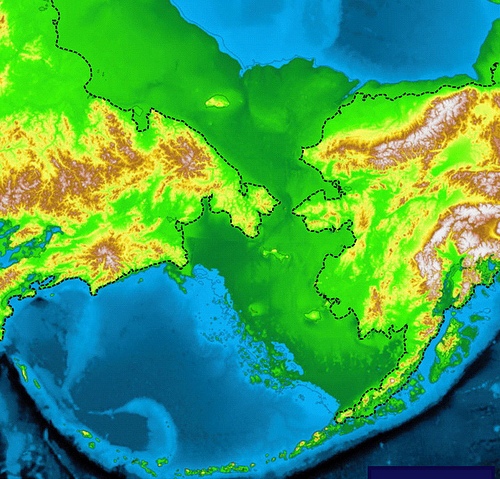 Map of ancient Beringia, showing the outlines of modern Siberia (left) and Alaska (right) with dashed lines. The area in dark green is the portion of Beringia (now submerged by the ocean) near the end of the last glacial maximum, a period that lasted from 28,000 to 18,000 years ago when sea levels were low and ice sheets extended south into what is now the northern part of the lower 48 states. Photo Credit: Wlliam Manley, Institute of Arctic and Alpine Research, University of Colorado. Illustration below: credit Julie McMahon
Map of ancient Beringia, showing the outlines of modern Siberia (left) and Alaska (right) with dashed lines. The area in dark green is the portion of Beringia (now submerged by the ocean) near the end of the last glacial maximum, a period that lasted from 28,000 to 18,000 years ago when sea levels were low and ice sheets extended south into what is now the northern part of the lower 48 states. Photo Credit: Wlliam Manley, Institute of Arctic and Alpine Research, University of Colorado. Illustration below: credit Julie McMahon
___________________________________________
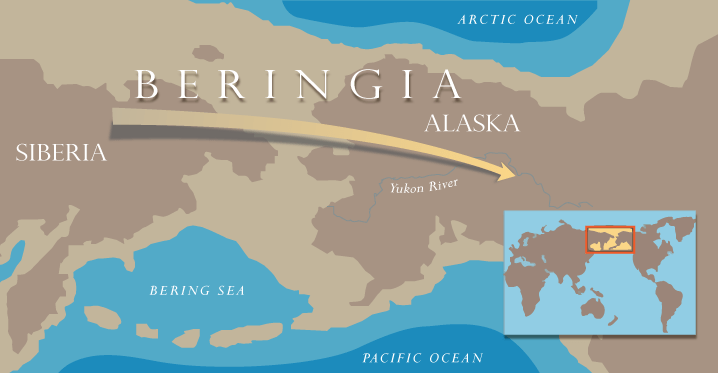 ______________________________________________
______________________________________________
Moving Forward
Although the Hoyo Negro findings have added significant additional support for the Beringian origins theory, the scientists caution that there is much more work to do before any far-reaching conclusions can be drawn. After all, Naia has shown that she is related to only 11 percent of all Native Americans. What about the other 89 percent? The findings thus far suggest that at least some modern-day Native Americans can trace their roots to an ancient Beringian population. But scientists have learned, over and over again, that the more they discover about human prehistory, the more they realize they don’t know. Reconstructing the past often turns out to be far more complicated than we initially suppose. And this, the Hoyo Negro scientists would likely agree, makes the whole journey of discovery all the more exciting.
“The dating and genetic analysis of Naia is a first step in what we hope will be a long productive investigation of Hoyo Negro,” says Chatters, looking ahead. “Our next steps will focus on attempting to sequence Naia’s nuclear DNA, determining the ages and genetics of the cave’s other animal skeletons and reconstructing the environment in which they and Naia lived.”
But it will all take a village of experts, just as it has to this point, employing a variety of disciplines and skills to re-create the evolving picture. “Balancing all of these elements has been a wonderful challenge,” says Pilar Luna from INAH. “On the one hand, we have a large team of renowned scientists who have been extremely generous sharing their knowledge and experience to analyze, understand, and interpret the findings, in order to produce the knowledge we have gotten so far. On the other hand, there are the cave divers, who have taken specialized courses to gather data for archaeological purposes, to properly record the general context taking samples, measurements, photos, videos, etc., and following with extreme care all requests made by the experts, in spite of the complexities and dangers of the cave itself. Also, we have had the support from engineers and technicians who have developed extraordinary methods to be used in this project for the first time, with significant results, mainly in the fields of software and photography.”
The combined efforts will extend to protecting the cave itself from would-be looters and other environmental dangers, so that research can continue as long as possible. “We feel obligated to protect this incredible resource,” says Nava. “So we are working with INAH and other Mexican authorities to control site access and make sure Hoyo Negro is preserved for future generations.”
Time will tell the ultimate fate of the Black Hole. In the meantime, what is collected of Naia’s remains will rest enshrined within laboratory walls and, perhaps in time, behind museum glass.
______________________________________________
Article Supplement
Naia’s World of Gomphotheres
When University of Arizona archaeologist Vance Holliday and colleagues began uncovering large fossilized bones at the site of El Fin del Mundo in the Sonoran Desert of northwestern Mexico in 2007, they weren’t sure what kind of animal they were unearthing.
“At first, just based on the size of the bone, we thought maybe it was a bison, because the extinct bison were a little bigger than our modern bison,” said Holliday, who has been researching geoarchaeology at Paleoindian sites across the U.S. for years.
Then, in 2008, they discovered something that clinched it for them.
“We finally found the mandible, and that’s what told the tale,” Holliday said.
It was a gomphothere.
Actually, two of them.
About the same size as a modern elephant, but smaller than their extinct cousins the mammoths, gomphotheres were once widespread in North America but were thought to have disappeared from the fossil record long before humans arrived in North America some 13,000 to 13,500 years ago.
Until now.
Radiocarbon dating of charcoal flecks and burned bone found within the context of the fossils indicated a reliable age of 13,390 years. This made these two gomphotheres the last known gomphotheres in North America.
________________________________
Gomphothere mandible in place, upside down, at El Fin del Mundo excavation site. The fossil was fully prepared at the INAH zooarchaeology lab in Mexico City. Image courtesy of Vance T. Holliday.
______________________________
The fully excavated and prepared gomphothere mandible. Courtesy Joaquin Arroyo-Cabrales/Instituto Nacional de Antropología e Historia
_____________________________
These sculptures, made by Mexican artist Sergio de la Rosa, show three elephant ancestors: (from left to right) the mastodon, the mammoth and the gomphothere. Courtesy Sergio de la Rosa
_______________________________
But there was more.
As they excavated among the bones, they also uncovered human artifacts—Clovis artifacts, to be specific—including 7 projectile points, some stone cutting tools and 21 flint flakes from stone tool-making. The position and proximity of the Clovis fragments relative to the gomphothere bones at the site suggested that humans did in fact kill the two animals there. Of the seven points found at the site, four were in place among the bones, including one with bone and teeth fragments above and below. The other three points had eroded away from the bone bed and were found scattered nearby. This suggested that the gomphotheres were likely hunted and thus constituted a Clovis prey species, along with mammoths, mastodons, and bison, already known to have been hunted by the Clovis.
________________________________
A clear quartz Clovis point found near the bone bed at El Fin del Mundo. Although very difficult to shape into a tool, quartz was used by Clovis tool makers at several sites. Courtesy INAH Sonora.
______________________________
“This is the first Clovis gomphothere, it’s the first archaeological gomphothere found in North America, it’s the first evidence that people were hunting gomphotheres in North America, and it adds another item to the Clovis menu,” Holliday said.
The Clovis culture, today considered the oldest clearly defined and recognized Paleoindian culture in the Americas, is characterized by its distinctive stone tools, particularly the fluted projectile points. The first examples of this culture were discovered by archaeologists near Clovis, New Mexico, in the 1930s. The El Fin del Mundo site, along with the Aubrey site in Texas, is now among two sites that show the earliest solid evidence of Clovis hunting in North America, indicating that the earliest widespread and recognizable group of hunter-gatherers were already in place 13,390 years ago in the North American Southwest.
Holliday and colleagues suggest that the finds support the model of an American southwestern origin for the Clovis material culture. As they conclude in the study, published this week in the Proceedings of the National Academy of Sciences:
“These data expand our understanding of the age range for Clovis, Clovis diet, raw material preference, and the late Pleistocene megafaunal assemblage of North America, and provide evidence for a southern origin of the Clovis technocomplex.”*
Holliday and the study team report that the radiocarbon ages from El Fin del Mundo were made based on testing the site’s charcoal, shell, and organic matter at the Arizona Accelerator Mass Spectrometry Laboratory.
____________________________________________
*Article #14-04546: “Human (Clovis)–gomphothere (Cuvieronius sp.) association ~13,390 calibrated yBP in Sonora, Mexico,” by Vance T. Holliday et al.
In addition to Holliday, authors of the PNAS paper include: lead author Guadalupe Sanchez, who has a doctorate in anthropology from the UA; UA alumni Edmund P. Gaines and Susan M. Mentzer; UA doctoral candidates Natalia Martínez-Tagüeña and Andrew Kowler; UA master’s student Ismael Sanchez-Morales; UA scientists Todd Lange and Gregory Hodgins; and Joaquin Arroyo-Cabrales at the Instituto Nacional de Antropología e Historia.
The dig at El Fin del Mundo, a joint effort between the U.S. and Mexico, was funded by the UA School of Anthropology’s Argonaut Archaeological Research Fund, the National Geographic Society, the Instituto Nacional de Antropología e Historia and The Center for Desert Archaeology in Tucson.
Source: Some material for this article was adapted and edited from a University of Arizona press release, Meet the gomphothere: UA archaeologist involved in discovery of bones of elephant ancestor
____________________________________________
Subscribe to Popular Archaeology Premium. Available on all laptops and mobile devices, and still the industry’s best value at only $9.00 annually.
___________________________________________
Travel and learn with Far Horizons.
____________________________________________
This richly illustrated issue includes the following stories: Recent findings shedding new light on the whereabouts of the remains of Philip of Macedon, father of Alexander the Great; how an archaeologist-sculptor is bringing bones of the dead back to life; archaeologists uncovering town life at the dawn of civilization; an exclusive interview with internationally acclaimed archaeologist James M. Adovasio about what makes the Meadowcroft Rockshelter prominent in the ongoing search for the first Americans; what archaeologists are finding at the site of the ancient city of Gath, the home town of the biblical Philistine giant, Goliath; and how scientists are redrawing the picture of human evolution in Europe. Find it on Amazon.com.

